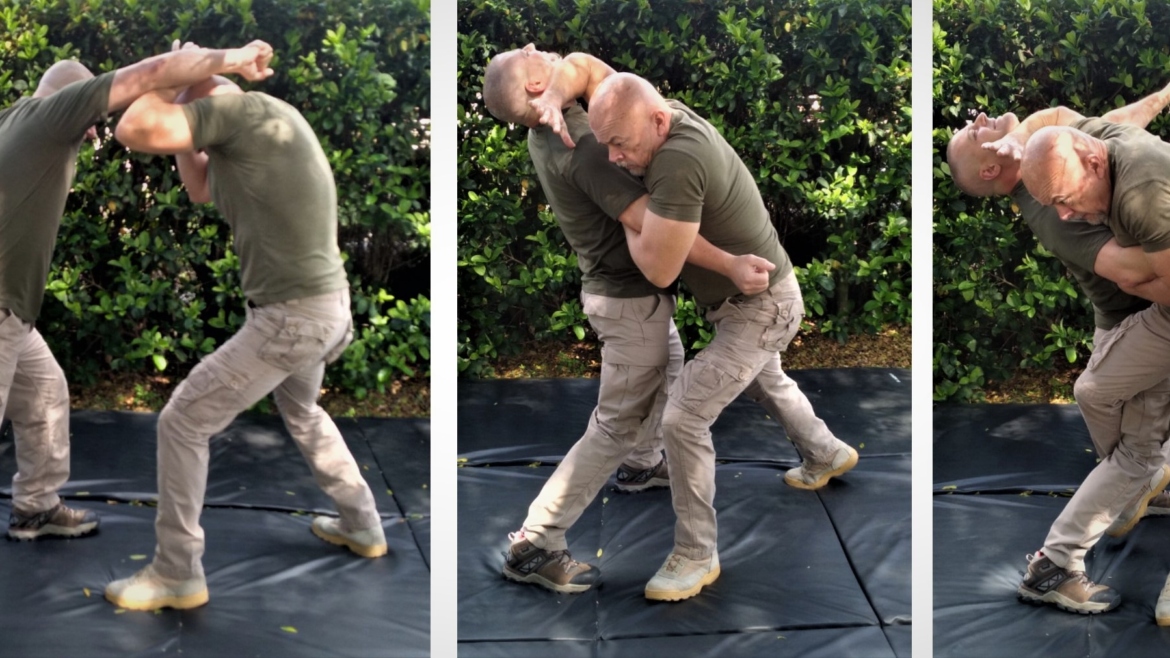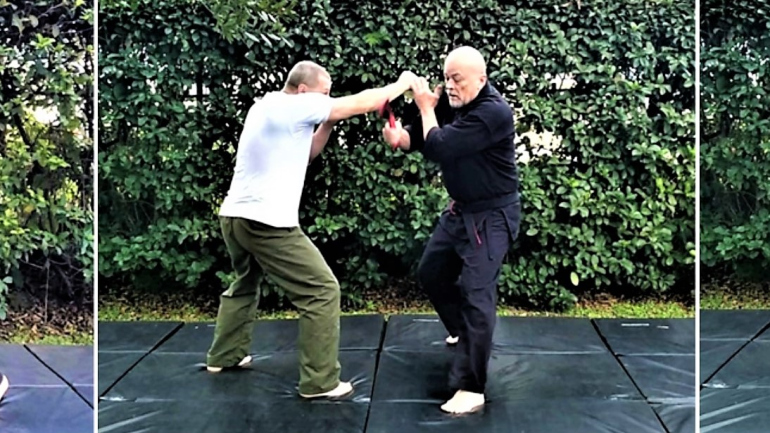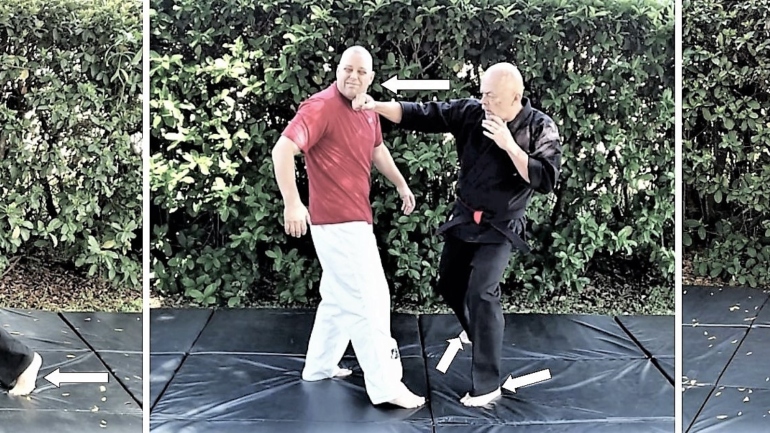There are several variations of the Cross-hock takedown and many ways to execute this technique under different circumstances and conditions and attack scenarios. The variations of the throws and takedowns are also meant to give the practitioner a better feel for applying the techniques as well as aide in being able to make micro adjustments, such as changes in grips or footwork or even moving into a completely different technique or throw during the execution of the takedown when in a fight.
Cross Hock takedown Variation – Single post (Leading with right foot)
The cross – hock takedown can be executed leading in with either foot. This variation is the exact same as the basic technique the only difference is you are stepping in with the right foot forward. The technique is delivered much in the same manner as a boxer throws a straight punch or the forward motion of a running back in football stiff arming a player who is trying to tackle him.
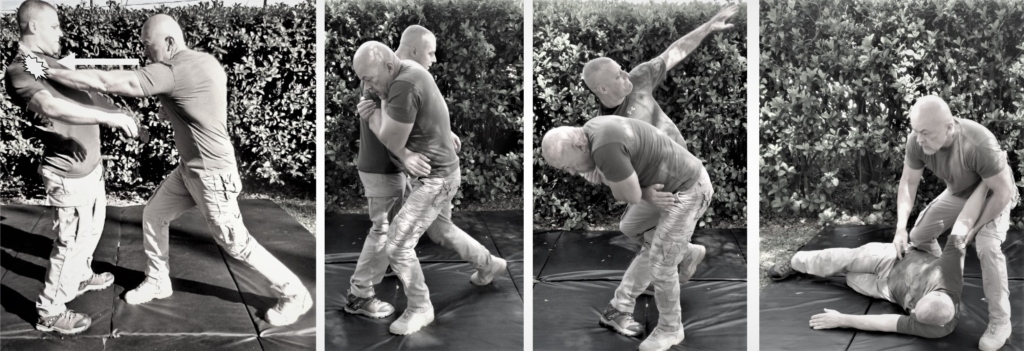
(1.) From either a fighting stance or non – violent posture. Push off the left foot and step in with the right foot. Simultaneously, STRIKE your opponent’s right shoulder with the heel of your left hand and grab the clothing at the area struck. (The blow to your opponent’s shoulders should be delivered hard enough to knock the opponent off balance.)
(2.) Push of the right foot stepping forward and to the outside of the opponent’s right foot with your left foot. Your weight shifts to the left foot and leg, maintaining the hold on his shoulder your right hand under hooks and clasps on his right arm. Pull his arm hard into your chest breaking his balance to his right leg. As you shift the weight bring your right knee forward and up in between your left leg and the outside of your opponent’s right leg. Your right thigh should be raised until it is parallel with the ground.
(3.) Swing your right leg downward and back without letting your right foot touch the ground and sweep your opponent’s leg upward. The back of your calf should make contact with the back of his calf as you sweep his leg high. As you sweep your opponent’s leg drive his shoulder downward to the ground.
(To do the cross-hock takedown to the opposite side substitute the word “left” for “right” and “right” for “left”.)
Common mistakes with the cross – hock takedown and it’s variations
1. Not keeping your axis forward.
2. Not stepping deep enough to the outside with left foot. Left foot should step to the outside of opponent’s foot. The toes of your left foot should be next to the opponent’s right foot even with the heel of his foot.
3. Reaching too far with sweeping leg which causes you to lean backwards. This generally means you haven’t stepped deep enough with the left foot.
How to train the Cross Hock takedown
When in training strive for precision and accuracy. Do each PHASE of the throw with deliberate action. Once you have thoroughly learned the cross hock takedown work for speed through constant practice.
PHASE ONE – You should enter and disrupt simultaneously. Entry and disruption should be accomplished in one move. As specified in instructions, take a step forward and at the same time STRIKE your opponent hard on his right shoulder with the heel of your left hand and grab his clothing at the area struck.
PHASE TWO – Left hand pulls as you enter, pushing off the right as in taking off in a sprint with knees bent, axis forward and stepping to the outside of his right foot and around behind him with your right foot, your right arm goes encircles his torso under his arm.
PHASE THREE – The opponent’s balance and posture should be disrupted, his weight on his right foot before sweeping the leg. Throw your opponent to the ground then work Follow up and Recovery techniques.
Follow up and Recovery techniques
Follow up and recovery techniques are ANY techniques that disable the attacker’s ability to injure you AFTER you have thrown your opponent to the ground. Your Follow up techniques whether lethal or non-lethal strikes, breaks or control and restraint techniques must be applied immediately after the throw as the fall from the throw itself may not be disabling.
Shoulder and Elbow lock
A shoulder and elbow lock can be applied as a hyperextension to control and restrain the opponent or as a break or dislocation.
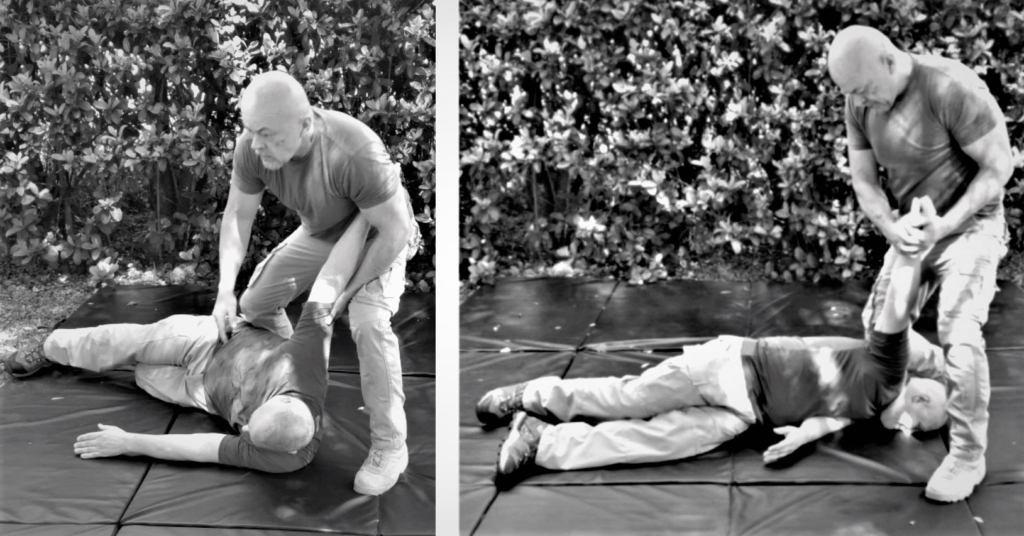 (1.) After the take down press your shin and knee against the back and side of your opponent and keep his arm trapped under your arm. This keeps him from rolling into or away from you.
(1.) After the take down press your shin and knee against the back and side of your opponent and keep his arm trapped under your arm. This keeps him from rolling into or away from you.
(2.) Get two on one control of the opponent’s wrist. Step over his head with your right foot and slide you left up behind his shoulder. Apply pressure with the knee downward and against the back of suspect’s arm and pull his arm back to your right hyper extending the opponent’s shoulder at your knee and his elbow against your thigh. (If utilized as a break or dislocation: a sudden quick wrenching type pressure of the arm against the knee and leg can dislocate the shoulder or elbow.)
Cover to Cross Hock takedown – Hack variation
Some attacks you can pick up on early while others you may pick up on late. Caught off guard you may not be in the best position. You may only have time to just cover your head with your arms. It is important to drill and practice techniques under these circumstances. Train to go from a covered position to getting into position to execute your takedown or throw.
In this variation you are caught somewhat off guard and you pick up on a incoming punch late and maybe all you have time to do is cover your head. Your opponent’s attack has closed the distance between you. The objective is to move forward from an unbalanced, caught off guard position and get your axis forward and drive him backward and disrupt his posture as soon as possible.
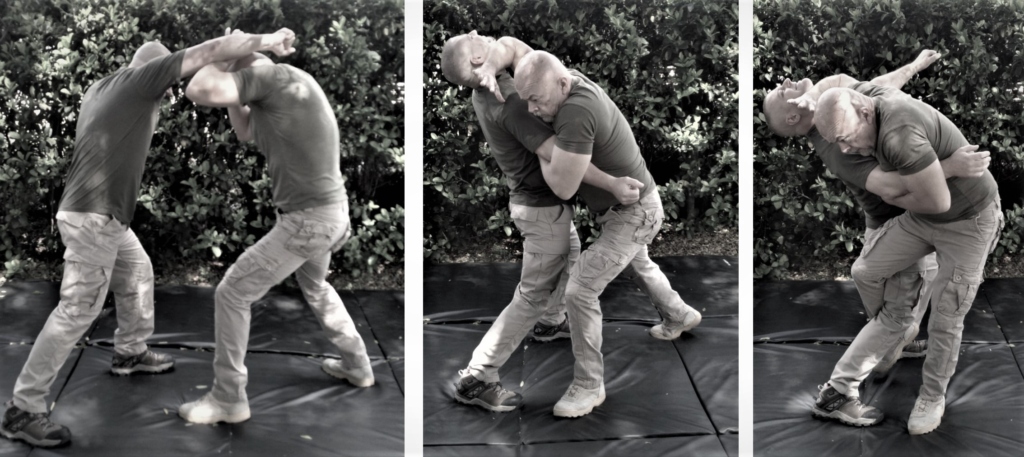
(1.) Your opponent has attempted a punch and you have been able to pick up on it at the last possible moment and could only bring up your arms to cover your head.
(2.) Push off the right foot and step off diagonally to the left with the right foot. Over hook the opponent’s right arm with your left arm and simultaneously strike him in the throat with the blade of your left forearm (forearm hack).
(3.) Get your axis forward and drive his axis backwards by pushing off with the right foot driving the forearm into his throat getting his head back beyond the plane of the heels of his feet.
(4.) Push off with the right foot and step diagonally to the outside of your opponent’s right foot with your left foot. As you shift the weight bring your right knee forward and up in between your left leg and the outside of your opponent’s right leg. Your right thigh should be raised until it is parallel with the ground.
(5.) Swing your right leg downward and back without letting your right foot touch the ground and sweep your opponent’s leg upward. The back of your calf should make contact with the back of his calf as you sweep his leg high. As you sweep your opponent’s leg drive his head downward to the ground. (CAUTION should be taken with this throw when in training as it could cause serious injury to neck and head.)
(To do the cross-hock takedown to the opposite side substitute the word “left” for “right” and “right” for “left”.)
